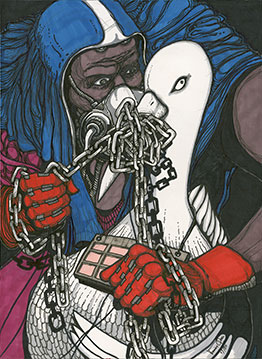INSIDE ART - SubRosa

The 2013 edition of Inside Art focuses on the USFCAM exhibition SubRosa: The Language of Resistance.
Referencing the ancient practice of hanging a rose to designate covert meetings, the Latin term sub rosa for centuries has denoted secrecy or confidentiality. The seven international artists in this exhibition are among the untold many around the world who contend with environments where censorship—real and threatened—violence and imprisonment are daily realities for those who speak out against the social and political oppression they experience. Together with their compatriots, these artists find ways to live with dignity, honesty and hope for change, and they choose to use their art for activism. Operating often in a sub rosa mode—covert, coded, dissimulated—they find languages for resistance in accomplished and intriguing works that span a range of media and registers, reaching diverse audiences in their own countries and across the world. Artists include Ai Weiwei (China), Ramón Esono Ebalé (Equatorial Guinea), Barbad Golshiri (Iran), Khaled Jarrar (Palestine), Zanele Muholi (South Africa), and José Toirac and Meira Marrero (Cuba).
Common Core State Standards – In addition to Visual Arts and Social Studies curriculum standards, lessons in the InsideArt curriculum cover Common Core standards related to:
- Reading: Informational Text
- Speaking and Listening
- Language
- Literacy in History/Social Studies
The links on this page allow you to download the index of the SubRosa lesson files.
- Click ONCE on links to open, or right click (control click) to download
- Files can be downloaded individually or as a complete archive (.zip) at the bottom of the page.
- Curriculum and readings are available as both Microsoft Word documents (.doc) and Adobe Acrobat documents (.pdf)
- Presentations are Microsoft PowerPoint presentations (.ppt)

Click ONCE on links to open, or right-click (control-click) to download
SubRosa Files
Lesson Files Index .pdf (or .doc)
One introductory lesson and 6 modules (3-day lesson plans for each of the artists).
1) Introductory Lesson
Lessons:
1A. Introductory Lesson presentation .ppt
1B. Introductory Lesson SubRosa .pdf (or .doc)
Ancillary Materials:
1C. SubRosa – Quotations by artists .pdf (or .doc)
2) Ai Weiwei
Lessons:
2A. Ai Weiwei and China .ppt
2B. Ai Weiwei Lesson 1 .pdf (or .doc)
2C. Ai Weiwei Artwork Analysis .ppt
2D. Ai Weiwei Lesson 2 .pdf (or .doc)
2E. Ai Weiwei Lesson 3 .pdf (or .doc)
2F. Art Project eval rubric (Ai Weiwei) .pdf (or .doc)
Ancillary Materials:
Little Red Book
- 2G. Mao Zedong’s Little Red Book Group 1 .pdf (or .doc)
- 2H. Mao Zedong’s Little Red Book Group 2 .pdf (or .doc)
- 2I. Mao Zedong’s Little Red Book Group 3 .pdf (or .doc)
- 2J. Mao Zedong’s Little Red Book Group 4 .pdf (or .doc)
- 2K. Mao Zedong’s Little Red Book Group 5 .pdf (or .doc)
2L. Ai Weiwe KWLQH .ppt
3) Toirac and Marrero
Lessons:
3A. Toirac, Marrero, and Cuba .ppt
3B. Toirac and Marrero Lesson 1 .pdf (or .doc)
3C. Toirac and Marrero Artwork Analysis .ppt
3D. Toirac and Marrero Lesson 2 .pdf (or .doc)
3E. Toirac and Marrero Lesson 3 .pdf (or .doc)
3F. Art Project Eval rubric (Toirac and Marrero) .pdf (or .doc)
Ancillary Materials:
3G. Berlin – Moscow – Havana (edited, with questions) .pdf (or .doc)
3H. Icons handout .pdf (or .doc)
3I. Marti quote .ppt
4) Ramon Esono Ebale
Lessons:
4A. Ramon Esono Ebale and Equatorial Guinea .ppt
4B. Ramon Esono Ebale Lesson 1 .pdf (or .doc)
4C. Ramon Esono Ebale Art Analysis .ppt
4D. Ramon Esono Ebale Lesson 2 .pdf (or .doc)
4E. Ramon Esono Ebale Lesson 3 .pdf (or .doc)
4F. Art Project Eval Rubric Ramon Esono Ebale .pdf (or .doc)
Ancillary Materials:
4G. Caricature .ppt
5) Barbad Golshiri
Lessons:
5A. Barbad Golshiri & Iran .ppt
5B. Barbad Golshiri Lesson 1 .pdf (or .doc)
5C. Barbad Golshiri Art Analysis .ppt
5D. Barbad Golshiri Lesson 2 .pdf (or .doc)
5E. Barbad Golshiri Lesson 3 .pdf (or .doc)
5F. Art Project Eval rubric (Barbad Golshiri) .pdf (or .doc)
6) Khaled Jarrar
Lessons:
6A. Khaled Jarrar and Palestine .ppt
6B. Khaled Jarrar Lesson 1 .pdf (or .doc)
6C. Khaled Jarrar Art Analysis .ppt
6D. Khaled Jarrar Lesson 2 .pdf (or .doc)
6E. Khaled Jarrar Lesson 3 .pdf (or .doc)
6F. Art Project eval Rubric (Khaled Jarrar) .pdf (or .doc)
Ancillary Materials:
6G. Guided Imagery al-Nakba, 1948 .pdf (or .doc)
7) Zanele Muholi
Lessons:
7A. Zanele Muholi and South Africa .ppt
7B. Zanele Muholi Lesson 1 .pdf (or .doc)
7C. Zanele Muholi Art Analysis .ppt
7D. Zanele Muholi Lesson 2 .pdf (or .doc)
7E. Zanele Muholi Lesson 3 .pdf (or .doc)
7F. Art Project Eval rubric (Zanele Muholi) .pdf (or .doc)
Ancillary Materials:
7G. Self-Portraits in Art .ppt
7H. Segregation .ppt
Download Complete Inside Art 2013 Materials
Lessons plus index (.zip - 111MB)

Further Resources:
USFCAM SubRosa: The Language of Resistance exhibition website (exhibition brochure PDF with essays, photographs of works, and complete exhibition checklist)
If you have questions about the lesson plans or about the SubRosa exhibition email an expert
ABOUT
InsideART is a project of the USF Institute for Research in Art: Contemporary Art Museum and Graphicstudio
Publications
Browse the academic publications related to the InsideART program.
Inside Art is generously supported by:
The SEA Foundation
Gobioff Foundation
USF College of The Arts
USF College of Education
Hillsborough County Public Schools
State of Florida, Department of State, Division of Cultural Affairs, Florida Council on Arts and Culture
USFCAM ACE (Arts for Community Engagement) Fund
National Education Association
The P/Arts Program of the Cornelia T. Bailey Foundation
Bank of America
The David C. Anchin Center at the USF College of Education
Copyright + Reproduction
The electronic images and information available on this site are subject to copyright and may be covered by other restrictions as well. The images are made available to the general public as a representation of USF Contemporary Art Museumís programs. Copy or redistribution in any manner for commercial use is not permitted. Anyone wishing to use any of these images for commercial use, publication, or for any purpose other than personal fair use must first request and receive prior written permission from the University of South Florida Institute for Research in Art. Please contact USFCAM at (813) 974-4133 for more information.